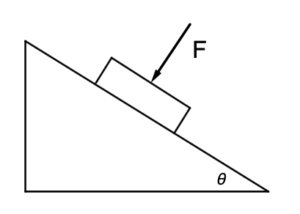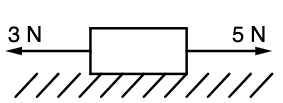| Step | Derivation/Formula | Reasoning |
|---|---|---|
| 1 | m = 5.5\,\text{kg} | The mass of the block. |
| 2 | g = 9.81\,\text{m/s}^2 | Acceleration due to gravity. |
| 3 | \theta = 30^\circ | Angle of the incline. |
| 4 | \mu = 0.20 | Coefficient of friction between the block and the incline. |
| 5 | F_{\text{gravity}} = mg \sin(\theta) | The component of gravitational force pulling the block down the incline. |
| 6 | F_{\text{friction}} = \mu N | The frictional force acting opposite to the direction of motion, where N is the normal force. |
| 7 | N = mg \cos(\theta) | Normal force exerted by the incline on the block, perpendicular to the surface. |
| 8 | F_{\text{friction}} = \mu mg \cos(\theta) | Substituting the expression for normal force into the friction formula. |
| 9 | F_{\text{net}} = mg \sin(\theta) – \mu mg \cos(\theta) | The net force acting on the block along the incline, which is the gravitational force minus the frictional force. |
| 10 | a = \frac{F_{\text{net}}}{m} | Net acceleration of the block, calculated using Newton’s second law (F = ma). |
| 11 | a = g (\sin(\theta) – \mu \cos(\theta)) | Solving for a by substituting the expressions into acceleration formula. |
| 12 | a = 9.81 (\sin(30^\circ) – 0.20 \cos(30^\circ)) | Calculating the numerical value of acceleration by plugging in values for g, \theta, and \mu. |
| 13 | a = 9.81 (0.5 – 0.20 \times 0.866) | Using trigonometric values for sine and cosine of 30 degrees. |
| 14 | a = 9.81 \times (0.5 – 0.1732) | Continuing the calculation. |
| 15 | a = 9.81 \times 0.3268 \approx 3.21\,\text{m/s}^2 | Final calculation of the acceleration. |
Phy can also check your working. Just snap a picture!
 A force F is used to hold a block of mass m on an incline as shown in the diagram above. The plane makes an angle of \theta with the horizontal and F is perpendicular to the plane. The coefficient of friction between the plane and the block is µ. What is the minimum force, F, necessary to keep the block at rest?
A force F is used to hold a block of mass m on an incline as shown in the diagram above. The plane makes an angle of \theta with the horizontal and F is perpendicular to the plane. The coefficient of friction between the plane and the block is µ. What is the minimum force, F, necessary to keep the block at rest?

The block is moving horizontally at a constant velocity. There are two applied forces on the object as shown in the image. In which direction is the friction force acting on the object?
A horizontal spring with spring constant 162 N/m is compressed 50 cm and used to launch a 3 kg box across a frictionless, horizontal surface. After the box travels some distance, the surface becomes rough. The coefficient of kinetic friction of the box on the rough surface is 0.2. Find the total distance the box travels before stopping.
A pulley system consists of two blocks of mass 5 kg and 10 kg, connected by a rope of negligible mass that passes over a pulley of radius 0.1 meters and mass 2 kg. The pulley is free to rotate about its axis. The system is released from rest, and the block of mass 10 kg starts to move downwards. Assuming that the coefficient of kinetic friction between the pulley and the rope is 0.2, and neglecting air resistance, determine
The steepest street in the world is Baldwin Street in Dunedin, New Zealand. It has an inclination angle of 38.0° with respect to the horizontal. Suppose a wooden crate with a mass of 25.0 kg is placed on Baldwin Street. An additional force of 59 N must be applied to the crate perpendicular to the pavement in order to hold the crate in place. If the coefficient of static friction between the crate and the pavement is 0.599, what is the magnitude of the frictional force?
3.2 m/s2
By continuing you (1) agree to our Terms of Sale and Terms of Use and (2) consent to sharing your IP and browser information used by this site’s security protocols as outlined in our Privacy Policy.
| Kinematics | Forces |
|---|---|
| \Delta x = v_i t + \frac{1}{2} at^2 | F = ma |
| v = v_i + at | F_g = \frac{G m_1m_2}{r^2} |
| a = \frac{\Delta v}{\Delta t} | f = \mu N |
| R = \frac{v_i^2 \sin(2\theta)}{g} |
| Circular Motion | Energy |
|---|---|
| F_c = \frac{mv^2}{r} | KE = \frac{1}{2} mv^2 |
| a_c = \frac{v^2}{r} | PE = mgh |
| KE_i + PE_i = KE_f + PE_f |
| Momentum | Torque and Rotations |
|---|---|
| p = m v | \tau = r \cdot F \cdot \sin(\theta) |
| J = \Delta p | I = \sum mr^2 |
| p_i = p_f | L = I \cdot \omega |
| Simple Harmonic Motion |
|---|
| F = -k x |
| T = 2\pi \sqrt{\frac{l}{g}} |
| T = 2\pi \sqrt{\frac{m}{k}} |
| Constant | Description |
|---|---|
| g | Acceleration due to gravity, typically 9.8 , \text{m/s}^2 on Earth’s surface |
| G | Universal Gravitational Constant, 6.674 \times 10^{-11} , \text{N} \cdot \text{m}^2/\text{kg}^2 |
| \mu_k and \mu_s | Coefficients of kinetic (\mu_k) and static (\mu_s) friction, dimensionless. Static friction (\mu_s) is usually greater than kinetic friction (\mu_k) as it resists the start of motion. |
| k | Spring constant, in \text{N/m} |
| M_E = 5.972 \times 10^{24} , \text{kg} | Mass of the Earth |
| M_M = 7.348 \times 10^{22} , \text{kg} | Mass of the Moon |
| M_M = 1.989 \times 10^{30} , \text{kg} | Mass of the Sun |
| Variable | SI Unit |
|---|---|
| s (Displacement) | \text{meters (m)} |
| v (Velocity) | \text{meters per second (m/s)} |
| a (Acceleration) | \text{meters per second squared (m/s}^2\text{)} |
| t (Time) | \text{seconds (s)} |
| m (Mass) | \text{kilograms (kg)} |
| Variable | Derived SI Unit |
|---|---|
| F (Force) | \text{newtons (N)} |
| E, PE, KE (Energy, Potential Energy, Kinetic Energy) | \text{joules (J)} |
| P (Power) | \text{watts (W)} |
| p (Momentum) | \text{kilogram meters per second (kgm/s)} |
| \omega (Angular Velocity) | \text{radians per second (rad/s)} |
| \tau (Torque) | \text{newton meters (Nm)} |
| I (Moment of Inertia) | \text{kilogram meter squared (kgm}^2\text{)} |
| f (Frequency) | \text{hertz (Hz)} |
General Metric Conversion Chart
Example of using unit analysis: Convert 5 kilometers to millimeters.
Start with the given measurement: \text{5 km}
Use the conversion factors for kilometers to meters and meters to millimeters: \text{5 km} \times \frac{10^3 \, \text{m}}{1 \, \text{km}} \times \frac{10^3 \, \text{mm}}{1 \, \text{m}}
Perform the multiplication: \text{5 km} \times \frac{10^3 \, \text{m}}{1 \, \text{km}} \times \frac{10^3 \, \text{mm}}{1 \, \text{m}} = 5 \times 10^3 \times 10^3 \, \text{mm}
Simplify to get the final answer: \boxed{5 \times 10^6 \, \text{mm}}
Prefix | Symbol | Power of Ten | Equivalent |
|---|---|---|---|
Pico- | p | 10^{-12} | 0.000000000001 |
Nano- | n | 10^{-9} | 0.000000001 |
Micro- | µ | 10^{-6} | 0.000001 |
Milli- | m | 10^{-3} | 0.001 |
Centi- | c | 10^{-2} | 0.01 |
Deci- | d | 10^{-1} | 0.1 |
(Base unit) | – | 10^{0} | 1 |
Deca- or Deka- | da | 10^{1} | 10 |
Hecto- | h | 10^{2} | 100 |
Kilo- | k | 10^{3} | 1,000 |
Mega- | M | 10^{6} | 1,000,000 |
Giga- | G | 10^{9} | 1,000,000,000 |
Tera- | T | 10^{12} | 1,000,000,000,000 |
The most advanced version of Phy. Currently 50% off, for early supporters.
per month
Billed Monthly. Cancel Anytime.
Trial –> Phy Pro
A quick explanation
UBQ credits are specifically used to grade your FRQs and GQs.
You can still view questions and see answers without credits.
Submitting an answer counts as 1 attempt.
Seeing answer or explanation counts as a failed attempt.
Lastly, check your average score, across every attempt, in the top left.
MCQs are 1 point each. GQs are 1 point. FRQs will state points for each part.
Phy can give partial credit for GQs & FRQs.
Phy sees everything.
It customizes responses, explanations, and feedback based on what you struggle with. Try your best on every question!
Understand you mistakes quicker.

For GQs and FRQs, Phy provides brief feedback as to how you can improve your answer.
Aim to increase your understadning and average score with every attempt!
10 Free Credits To Get You Started
*Phy Pro members get unlimited credits

By continuing you agree to nerd-notes.com Terms of Service, Privacy Policy, and our usage of user data.